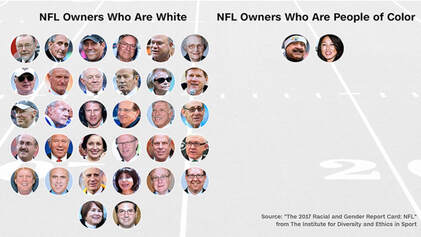
For the inclusive excellence specialist on the college campus, encouraging broad and wide engagement of THE faculty member in this work can be an oft-challenging pursuit. The reasons vary and I've found can range from point to point along the convincing to eye-rolling spectrum. Regardless of response, it is imperative THE faculty member remain central to the infusion of inclusive excellence on campus. They are our front-line workers that carry the ability to move the work at a productive and meaningful pace. Without THE faculty member comradery, administrative design and aspiration over inclusive pedagogy, praxis and responsiveness will fall short of its desired outcome.
CALLING ALL troubled Vice Presidents and Provosts, Deans and Executive Directors, Faculty Directors and THE inspired faculty member with roles, responsibilities, duties, and volunteer passions to engage your academic area in thought conversations around DEI! What comes next is exclusively for YOU.
Answer the “Why?”
Faculty are smart. As a member of faculty over the last decade, my views here may be a biased, however, I am increasingly convinced engaging faculty in the work of DEI, without the threat of meeting fear or suspicion, must begin with “the why.” As national conversations over DEI increase and administratively enter the teaching and learning realm, it is imperative DEI practitioners recognize the sacredness of the space and provide faculty with value-laden justification of what may seem like external interference. I have found virtue in being direct about the “why” before any activity commences. Doing so helps alleviate what is often misplaced fear, anxiety, and suspicion. Being able to point the “why” back to institutional values and commitments, I find, provides the best climate and opportunity to do this work with an engaged faculty.
Prepare an audit/tour.
As a DEI administrator, it is entirely plausible to enter this work with misguided assumptions that you were hired to “fix” faculty teaching and learning approaches. Such an assumption is costly, both for relational and operational reasons. It is wise for DEI practitioners to spend some time first learning what is happening on the ground! A firm understanding of what students are experiencing, some of the challenges faculty are facing, and what some immediate needs are, must be ascertained prior to meaningfully conducting this work with faculty. Unless one seeks to run the risk of alienation, taking the necessary time to ask questions, view classroom recordings and syllabi, and understand important nuance will likely generate favorable outcomes.
Provide examples of inclusive postures and opportunity areas.
I will bet the farm (I am neither a betting man nor do I own a farm, for what it is worth) that as a more accurate understanding of what is happening “on the ground” emerges, so, too, will excellent examples of inclusive postures and practices. Often, faculty just do not know how their leadership in the learning experience helps or hinders the creation of an inclusive space. Thus, there will be opportunities (after the “tour”) to use peer examples of what excellence in teaching and learning can look like, that may even surprise those that are/have adopted the approach! It is critical that the good work already being done is affirmed! There will also be opportunities to provide examples of gaps and/or opportunities that exist towards the robust creation of an inclusive learning environment. This is where the hard work begins.
Refrain from top-down approaches and partner and equip.
As the work commences, it is critical that DEI administrators avoid leveraging positional authority to lead faculty and instead utilize authentic, peer-based strategies and partnerships. Frankly, the faculty are the experts in their discipline, not me. Ensuring that faculty sense genuine collaboration and partnerships is both strategic and will bear more fruit. Allowing faculty to bring in their own knowledge and expertise of subject matter and pedagogical/andragogic approaches to the larger discussion of diversity, equity, and inclusion in the learning environment will only help. As such, offering grassroot opportunities for faculty learning and development with administrative guidance is a good strategy to maintain faculty sovereignty and autonomy while ensuring administrative leadership.
Empower early adopters.
Research suggests that in most communities of teaching and learning, there will be a myriad of postures towards the work of DEI. A cross-section of this group are those known as the “early adopters.” My observations over the last decade, specifically within the last five years, have led me to believe how DEI administrators engage the early adopters can impact the trajectory of the work in both helpful and potentially challenging ways. By definition, early adopters are, and have been, doing the work of DEI before the practitioner’s arrival. As a DEI administrator, it is important that embedded in the work is genuine appreciation of the early adopters. Competing with them, seeing them as adversaries or a distraction to the work will only limit its potential. Celebrating them, empowering them, providing the early adopters with leadership opportunities in the DEI teaching and learning space will propel the work forward. A philosophy of humility, recognizing that I am not the only expert and empowering those that exhibit proficiency and passion, will attract more so than detract faculty engagement.
Consider triangulating learning and development opportunities.
My political science background introduced to me to the concept of triangulation, an approach that simply suggests “mixing up” how one resources themselves and others. I find this philosophy greatly aids how I resource faculty. I have come to understand the myriad of sensitivities attached to this work that compels people like me to provide a variety of ways faculty can engage the broader topic. While committees are always a fun way to resource colleagues, some may prefer on-line methods that simply involve accessing resource links. Since on-line resourcing can be too distant for some, providing opportunities to learn and develop through lectures or workshops may better meet the needs of others. Unsurprisingly, offering diverse approaches for faculty growth and development around DEI teaching and learning is a wise strategy towards the pursuit of holistic faculty engagement.
Incentivize by rewarding enthusiasm with additional resourcing!
What would it look like if, instead of plaques and gift cards, enthusiasm and excellence in inclusive teaching was rewarded by additional resourcing to better hone skills? I find that truly invested faculty appreciate more the reinvestment of their growth and successes in increased opportunities to research, present at and attend conferences, workshops, among others, than they do through other recognition promoting measures that do not necessarily further accelerate their proficiency and competencies with inclusive teaching.
-----Shift from faculty engagement ideas to administrative faculty engagement ideas-----
Assessment Strategies?
When I work with administrative faculty leaders such as deans and provosts in the academic realm, it is important I steward well my relationship with faculty by advocating on their behalf to senior academic leaders. As I invite faculty engagement into the DEI teaching and learning space, I must also inquire with senior leadership on ways to assess and evaluate faculty effectiveness and movement with inclusive teaching. Are student evaluations over impressions related to inclusive teaching part of DEI assessment and measurement? If so, what role do they play in yearly faculty evaluation? If not, is it important to consider implementing such an approach?
Tangible promotion/advancement opportunities alongside Faculty DEI pursuit?
Are student, peer, and colleague impressions of how one keeps an inclusive environment tied to tangible outcomes such as rank promotion, sabbaticals, and/or professional advancement and increase in compensation? Stewarding my relationship well with faculty involves asking hard questions of those that lead them and ultimately returns to the “why,” which must be clearly articulated back to faculty. While I may find the moral and humanistic imperatives of inclusive teaching compelling enough to consider adopting meaningful measures in my virtual and onsite courses, I also understand other faculty may simultaneously desire to know how doing so better elevates them professionally.
Educationally rooted and embedded?
How engrained are the virtues of intercultural learning and culturally responsive teaching in the general curriculum? While I understand some universities primarily serve graduate students and “general education” may look different in this context, I think the broader question is still a worthwhile one to engage. In my journey, I have found faculty are likely to feel more empowered and become emboldened with inclusive teaching and learning when offered opportunities to create and teach courses that reflect the posture at-large. Engaging faculty in the DEI space requires the simultaneous “petition” to senior academic leaders of ways to best institutionally support them in the pursuit.
----
I consider this APPRECIATE philosophy two sides of the same coin; meaning, it is likely you cannot have one side without the other, and each side is of equal value. One side of this coin contains my plea for faculty to appreciate the challenges and opportunities of entering the DEI space to boldly conduct the work for the sake of our students. An inclusive teacher is an effective teacher to all students; however, an effective teacher will not always guarantee an all-encompassing inclusive one. The academy has many effective teachers but not because they are intentionally inclusive. They are only effective to some. The invitation to appreciate this challenge and opportunity in the pursuit of becoming an inclusive, ergo, better teacher to all, is at the forefront of my philosophy.
On the other side of the coin, APPRECIATE extends to how DEI practitioners engage the expertise and leverage the autonomy of the faculty and includes how I advocate for them, alongside them, as the journey continues. I do not believe in swarming faculty with policy, procedure, and expectations. Although there is a place for ensuring objectives and strategic initiatives are reached, this work is best conducted through an enhanced focus on the faculty member. Leveraging her experiences, knowledge, and aptitude to partner in the pursuit of inclusive and culturally responsive teaching and learning. This theme of partnership also extends to my relationship with senior faculty administrators. In my journey, I have found that creating pathways and plans for exceptional inclusive teachers to professionally advance in their careers is an often overlooked yet critical part of this work. A failure to appreciate the strengths and aptitude of the primary and proximate vessel through which this work is done will create barriers, not breakthrough.
CALLING ALL troubled Vice Presidents and Provosts, Deans and Executive Directors, Faculty Directors and THE inspired faculty member with roles, responsibilities, duties, and volunteer passions to engage your academic area in thought conversations around DEI! What comes next is exclusively for YOU.
Answer the “Why?”
Faculty are smart. As a member of faculty over the last decade, my views here may be a biased, however, I am increasingly convinced engaging faculty in the work of DEI, without the threat of meeting fear or suspicion, must begin with “the why.” As national conversations over DEI increase and administratively enter the teaching and learning realm, it is imperative DEI practitioners recognize the sacredness of the space and provide faculty with value-laden justification of what may seem like external interference. I have found virtue in being direct about the “why” before any activity commences. Doing so helps alleviate what is often misplaced fear, anxiety, and suspicion. Being able to point the “why” back to institutional values and commitments, I find, provides the best climate and opportunity to do this work with an engaged faculty.
Prepare an audit/tour.
As a DEI administrator, it is entirely plausible to enter this work with misguided assumptions that you were hired to “fix” faculty teaching and learning approaches. Such an assumption is costly, both for relational and operational reasons. It is wise for DEI practitioners to spend some time first learning what is happening on the ground! A firm understanding of what students are experiencing, some of the challenges faculty are facing, and what some immediate needs are, must be ascertained prior to meaningfully conducting this work with faculty. Unless one seeks to run the risk of alienation, taking the necessary time to ask questions, view classroom recordings and syllabi, and understand important nuance will likely generate favorable outcomes.
Provide examples of inclusive postures and opportunity areas.
I will bet the farm (I am neither a betting man nor do I own a farm, for what it is worth) that as a more accurate understanding of what is happening “on the ground” emerges, so, too, will excellent examples of inclusive postures and practices. Often, faculty just do not know how their leadership in the learning experience helps or hinders the creation of an inclusive space. Thus, there will be opportunities (after the “tour”) to use peer examples of what excellence in teaching and learning can look like, that may even surprise those that are/have adopted the approach! It is critical that the good work already being done is affirmed! There will also be opportunities to provide examples of gaps and/or opportunities that exist towards the robust creation of an inclusive learning environment. This is where the hard work begins.
Refrain from top-down approaches and partner and equip.
As the work commences, it is critical that DEI administrators avoid leveraging positional authority to lead faculty and instead utilize authentic, peer-based strategies and partnerships. Frankly, the faculty are the experts in their discipline, not me. Ensuring that faculty sense genuine collaboration and partnerships is both strategic and will bear more fruit. Allowing faculty to bring in their own knowledge and expertise of subject matter and pedagogical/andragogic approaches to the larger discussion of diversity, equity, and inclusion in the learning environment will only help. As such, offering grassroot opportunities for faculty learning and development with administrative guidance is a good strategy to maintain faculty sovereignty and autonomy while ensuring administrative leadership.
Empower early adopters.
Research suggests that in most communities of teaching and learning, there will be a myriad of postures towards the work of DEI. A cross-section of this group are those known as the “early adopters.” My observations over the last decade, specifically within the last five years, have led me to believe how DEI administrators engage the early adopters can impact the trajectory of the work in both helpful and potentially challenging ways. By definition, early adopters are, and have been, doing the work of DEI before the practitioner’s arrival. As a DEI administrator, it is important that embedded in the work is genuine appreciation of the early adopters. Competing with them, seeing them as adversaries or a distraction to the work will only limit its potential. Celebrating them, empowering them, providing the early adopters with leadership opportunities in the DEI teaching and learning space will propel the work forward. A philosophy of humility, recognizing that I am not the only expert and empowering those that exhibit proficiency and passion, will attract more so than detract faculty engagement.
Consider triangulating learning and development opportunities.
My political science background introduced to me to the concept of triangulation, an approach that simply suggests “mixing up” how one resources themselves and others. I find this philosophy greatly aids how I resource faculty. I have come to understand the myriad of sensitivities attached to this work that compels people like me to provide a variety of ways faculty can engage the broader topic. While committees are always a fun way to resource colleagues, some may prefer on-line methods that simply involve accessing resource links. Since on-line resourcing can be too distant for some, providing opportunities to learn and develop through lectures or workshops may better meet the needs of others. Unsurprisingly, offering diverse approaches for faculty growth and development around DEI teaching and learning is a wise strategy towards the pursuit of holistic faculty engagement.
Incentivize by rewarding enthusiasm with additional resourcing!
What would it look like if, instead of plaques and gift cards, enthusiasm and excellence in inclusive teaching was rewarded by additional resourcing to better hone skills? I find that truly invested faculty appreciate more the reinvestment of their growth and successes in increased opportunities to research, present at and attend conferences, workshops, among others, than they do through other recognition promoting measures that do not necessarily further accelerate their proficiency and competencies with inclusive teaching.
-----Shift from faculty engagement ideas to administrative faculty engagement ideas-----
Assessment Strategies?
When I work with administrative faculty leaders such as deans and provosts in the academic realm, it is important I steward well my relationship with faculty by advocating on their behalf to senior academic leaders. As I invite faculty engagement into the DEI teaching and learning space, I must also inquire with senior leadership on ways to assess and evaluate faculty effectiveness and movement with inclusive teaching. Are student evaluations over impressions related to inclusive teaching part of DEI assessment and measurement? If so, what role do they play in yearly faculty evaluation? If not, is it important to consider implementing such an approach?
Tangible promotion/advancement opportunities alongside Faculty DEI pursuit?
Are student, peer, and colleague impressions of how one keeps an inclusive environment tied to tangible outcomes such as rank promotion, sabbaticals, and/or professional advancement and increase in compensation? Stewarding my relationship well with faculty involves asking hard questions of those that lead them and ultimately returns to the “why,” which must be clearly articulated back to faculty. While I may find the moral and humanistic imperatives of inclusive teaching compelling enough to consider adopting meaningful measures in my virtual and onsite courses, I also understand other faculty may simultaneously desire to know how doing so better elevates them professionally.
Educationally rooted and embedded?
How engrained are the virtues of intercultural learning and culturally responsive teaching in the general curriculum? While I understand some universities primarily serve graduate students and “general education” may look different in this context, I think the broader question is still a worthwhile one to engage. In my journey, I have found faculty are likely to feel more empowered and become emboldened with inclusive teaching and learning when offered opportunities to create and teach courses that reflect the posture at-large. Engaging faculty in the DEI space requires the simultaneous “petition” to senior academic leaders of ways to best institutionally support them in the pursuit.
----
I consider this APPRECIATE philosophy two sides of the same coin; meaning, it is likely you cannot have one side without the other, and each side is of equal value. One side of this coin contains my plea for faculty to appreciate the challenges and opportunities of entering the DEI space to boldly conduct the work for the sake of our students. An inclusive teacher is an effective teacher to all students; however, an effective teacher will not always guarantee an all-encompassing inclusive one. The academy has many effective teachers but not because they are intentionally inclusive. They are only effective to some. The invitation to appreciate this challenge and opportunity in the pursuit of becoming an inclusive, ergo, better teacher to all, is at the forefront of my philosophy.
On the other side of the coin, APPRECIATE extends to how DEI practitioners engage the expertise and leverage the autonomy of the faculty and includes how I advocate for them, alongside them, as the journey continues. I do not believe in swarming faculty with policy, procedure, and expectations. Although there is a place for ensuring objectives and strategic initiatives are reached, this work is best conducted through an enhanced focus on the faculty member. Leveraging her experiences, knowledge, and aptitude to partner in the pursuit of inclusive and culturally responsive teaching and learning. This theme of partnership also extends to my relationship with senior faculty administrators. In my journey, I have found that creating pathways and plans for exceptional inclusive teachers to professionally advance in their careers is an often overlooked yet critical part of this work. A failure to appreciate the strengths and aptitude of the primary and proximate vessel through which this work is done will create barriers, not breakthrough.



